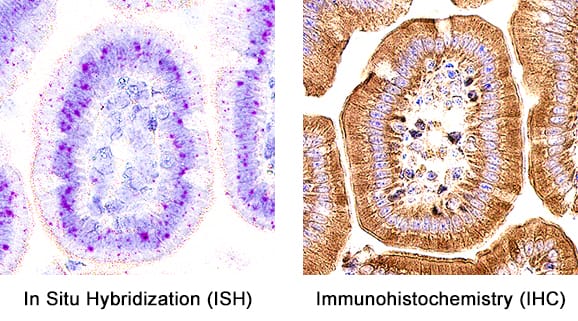Mouse IL-15 Antibody Best Seller
R&D Systems, part of Bio-Techne | Catalog # AF447


Key Product Details
Species Reactivity
Validated:
Mouse
Cited:
Mouse
Applications
Validated:
Dual RNAscope ISH-IHC Compatible, Immunohistochemistry, Neutralization, Western Blot
Cited:
ELISA Development, Immunocytochemistry, Immunohistochemistry, Immunohistochemistry-Frozen, Neutralization, Western Blot
Label
Unconjugated
Antibody Source
Polyclonal Goat IgG
Product Summary for Mouse IL-15 Antibody
Specificity
Detects mouse IL-15 in direct ELISAs and Western blots. In direct ELISAs, approximately 15% cross-reactivity with recombinant human IL‑15 is observed.
Clonality
Polyclonal
Host
Goat
Isotype
IgG
Scientific Data Images for Mouse IL-15 Antibody
Cell Proliferation Induced by IL‑15 and Neutralization by Mouse IL‑15 Antibody.
Recombinant Mouse IL-15 (Catalog # 447-ML) stimulates proliferation in the CTLL-2 mouse cytotoxic T cell line in a dose-dependent manner (orange line) as measured by Resazurin (Catalog # AR002). Proliferation elicited by Recombinant Mouse IL-15 (30 ng/mL) is neutralized (green line) by increasing concentrations of Goat Anti-Mouse IL-15 Antigen Affinity-purified Polyclonal Antibody (Catalog # AF447). The ND50 is typically 0.4-2.4 µg/mL.IL-15 in Mouse Intestine.
IL-15 was detected in immersion fixed frozen sections of mouse intestine (Peyer patch) using Goat Anti-Mouse IL-15 Antigen Affinity-purified Polyclonal Antibody (Catalog # AF447) at 15 µg/mL overnight at 4 °C. Tissue was stained using the Anti-Goat HRP-DAB Cell & Tissue Staining Kit (brown; Catalog # CTS008) and counterstained with hematoxylin (blue). Specific labeling was localized to the cytoplasm of lymphocytes in villi. View our protocol for Chromogenic IHC Staining of Frozen Tissue Sections.Detection of IL-15 in Mouse Intestine.
Formalin-fixed paraffin-embedded tissue sections of mouse intestine were probed for IL-15 mRNA (ACD RNAScope Probe, catalog # 440651; Fast Red chromogen, ACD catalog # 322360). Adjacent tissue section was processed for immunohistochemistry using goat anti-mouse IL-15 polyclonal antibody (R&D Systems catalog # AF447) at 1ug/mL with overnight incubation at 4 degrees Celsius followed by incubation with anti-goat IgG VisUCyte HRP Polymer Antibody (Catalog # VC004) and DAB chromogen (yellow-brown). Tissue was counterstained with hematoxylin (blue). Specific staining was localized to glandular cells.Applications for Mouse IL-15 Antibody
Application
Recommended Usage
Dual RNAscope ISH-IHC Compatible
5-15 µg/mL
Sample: Immersion fixed paraffin-embedded sections of mouse intestine
Sample: Immersion fixed paraffin-embedded sections of mouse intestine
Immunohistochemistry
5-15 µg/mL
Sample: Perfusion fixed frozen sections of mouse intestine (Peyer patch)
Sample: Perfusion fixed frozen sections of mouse intestine (Peyer patch)
Western Blot
0.1 µg/mL
Sample: Recombinant Mouse IL-15 (Catalog # 447-ML)
Sample: Recombinant Mouse IL-15 (Catalog # 447-ML)
Neutralization
Measured by its ability to neutralize IL‑15-induced proliferation in the CTLL‑2 mouse cytotoxic T cell line. Avanzi, G. et al. (1988) Br. J. Haematol. 69:359. The Neutralization Dose (ND50) is typically 0.4-2.4 µg/mL in the presence of 30 ng/mL Recombinant Mouse IL‑15.
Please Note: Optimal dilutions of this antibody should be experimentally determined.
Formulation, Preparation, and Storage
Reconstitution
Reconstitute at 0.2 mg/mL in sterile PBS. For liquid material, refer to CoA for concentration.
Formulation
Lyophilized from a 0.2 μm filtered solution in PBS with Trehalose. See Certificate of Analysis for details.
*Small pack size (-SP) is supplied either lyophilized or as a 0.2 µm filtered solution in PBS.
*Small pack size (-SP) is supplied either lyophilized or as a 0.2 µm filtered solution in PBS.
Stability & Storage
Store the unopened product at -20 to -70 °C. Use a manual defrost freezer and avoid repeated freeze-thaw cycles. Do not use past expiration date.
Background: IL-15
References
- Grabstein, K. et al. (1994) Science 264:965.
- Budagian, V. et al. (2006) Cytokine Growth Factor Rev. 17:259.
- Ma, A. et al. (2006) Annu. Rev. Immunol. 24:657.
- Tagaya, Y. et al. (1997) Proc. Natl. Acad. Sci. USA 94:14444.
- Giri, J.G. et al. (1995) EMBO 14:3654.
- Giri, J. et al. (1994) EMBO J. 13:2822.
- Duitman, E.H. et al. (2008) Mol. Cell. Biol. 28:4851.
- Dubois, S. et al. (2002) Immunity 17:537.
- Stonier, S.W. and K.S. Schluns (2010) Immunol. Lett. 127:85.
- Burkett, P.R. et al. (2004) J. Exp. Med. 200:825.
- Budagian, V. et al. (2004) J. Biol. Chem. 279:40368.
- Mortier, E. et al. (2004) J. Immunol. 173:1681.
- Bulanova, E. et al. (2007) J. Biol. Chem. 282:13167.
- Budagian, V. et al. (2004) J. Biol. Chem. 279:42192.
- Neely, G.G. et al. (2004) J. Immunol. 172:4225.
Long Name
Interleukin 15
Alternate Names
IL15
Entrez Gene IDs
Gene Symbol
IL15
UniProt
Additional IL-15 Products
Product Documents for Mouse IL-15 Antibody
Product Specific Notices for Mouse IL-15 Antibody
For research use only
